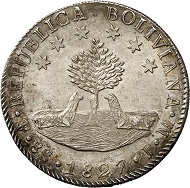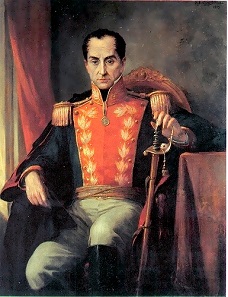courtesy of the MoneyMuseum, Zurich
translated by Teresa Teklic
Why was the human head the motif on coins for centuries, no, for millennia? And why did that change in the last 200 years? Ursula Kampmann is looking for answers to these questions in her book “MenschenGesichter” (“Human faces”), from which the texts in this series are taken.
Bolivia. 8 soles 1827, Potosí. Bust of Simón Bolívar in uniform with laurel wreath. R. Tree between two llamas, above six stars. © MoneyMuseum, Zurich.
In less than two decades the Spanish provinces in South America won their freedom. The hero in this fight was Simón Bolívar, who took a leading role in the wars of independence right from the beginning.
Simón Bolívar, born 1783 in Caracas, was a descendant of one of the richest Latin American families with excellent ties to Europe. So he travelled to France already as a young man, where, at the time of his visit, the French Revolution was in full swing. The new ideas inspired the young man and later on (after 1810) you would always be sure to find him wherever armed forces made attempts to drive the Spanish troops out of the Latin America.
Ricardo Acevedo Bernal, portrait of Simón Bolívar. Source: Wikicommons.
Simón Bolívar certainly was no social reformer or democrat, nor did he care for the abolition of slavery or the political equality of rich and poor. He was no more and no less than the greatest war hero, who helped one Spanish province after the other to independence: Venezuela, Colombia, Panama, Ecuador, Peru, and finally, in August 1825, Alto Perú, an impenetrable highland, where the Spanish troops had held out until the end in order to defend the rich silver resources of Potosí.
Alto Perú had already fallen to Bolívar’s followers in February 1825. They did not even have to fight for it as the Spanish had realised any further resistance was futile. Now the question arose to which state the conquered territory should be adjoined. Both Peru and Argentina laid claims to the land and its silver resources. During those years, Simón Bolívar was the dictator of Peru and, in the name of freedom, suggested to grant Alto Perú independence. Argentina was willing to accept this proposal. It urgently needed Bolívar’s support in its fight against Brazil.
So it happened that a constituent assembly met on 10 July 1825 in a city with the unpronounceable name Chuquisaca. In Chuquisaca, independence was proclaimed by 39 delegates. As a token of gratitude to Bolívar, they named the young republic Republica Bolívar, later changed to “Bolivia”, and decorated the first coins, issued in 1827, with the portrait of Bolívar, the liberator.
Just how much Bolivia owed to Bolívar became apparent to its population shortly after his death, when the fragile peace between the still young nations could not be preserved any longer. Bloody conflicts again spread in South America, although this time they were not interested in freedom but “only” in power.
The next episode will take a look at one of the trailblazers of the Third Reich: Paul von Hindenburg.
You can find all episodes in the series here.
A German edition of the book “MenschenGesichter” is available in print and as ebook on the site of the Conzett Verlag.








